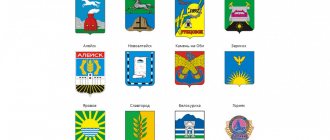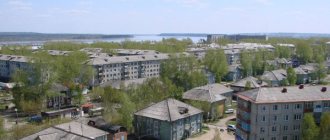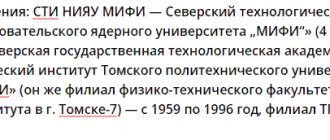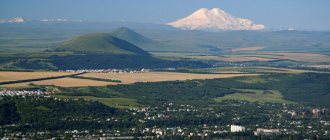Bogorodsk is a small town in the Nizhny Novgorod region, an administrative regional center. Its area is approximately 54.5 kilometers.
The satellite map of Bogorodsk shows that the outskirts of the city consist of several districts, separated from each other by the territories of the region.
- The city was founded in the 16th century as a trading village of Bogorodskoye.
- Bogorodsk developed thanks to crafts related to leather dressing.
- Bogorodsk received city status in 1923.
Today the city's population numbers more than 38 thousand inhabitants - it is one of the largest settlements in the Nizhny Novgorod region.
Bogorodsk on the map of Russia: geography, nature and climate
On the map of Russia, Bogorodsk can be found southwest of Nizhny Novgorod, 7 kilometers from the Oka on the banks of the Ryazanka River .
The city is located on the flat part of a swampy basin.
The eastern outskirts of the city are surrounded by ravines.
Bogorodsk is conventionally divided into two parts by a lake - the “ Kabatsky swamp ”.
The climate is temperate continental: cold winters, moderately warm summers, with moderate rainfall.
The lowest air temperatures are recorded in January, the warmest in July.
The Bogorodsky district is located in a zone of mixed forests with a predominance of deciduous trees.
Entertainment and attractions of Bogorodsk
Today's Bogorodsk has retained in its appearance the features of a wealthy large village: well-built merchant mansions, shop premises, some of which are still used as retail space. The new Church of the Intercession of the Virgin Mary (16 Venetskogo St.) also reminds us of antiquity, despite the fact that it was built in the 1990s. Its blue and white building with golden domes became the architectural and spiritual center of the city.
In 2003, a healing spring was built in Bogorodsk, and next to it a chapel was built in honor of the Holy Equal-to-the-Apostles Prince Vladimir. It was consecrated in front of a large crowd of people, and it was during this holiday that the beginning of the Russian church-wide movement “Return to Origins” was laid.
Almost in the center of the city there is a small but quite picturesque lake Kabatskoye. It seems that time has frozen on its shores: just like a hundred years ago, two-story wooden mansions and the crowns of old trees are reflected in the surface of the lake.
Routes on the map of Bogorodsk. Transport infrastructure
P125 “Ryazhsk – Kasimov – Murom – Nizhny Novgorod” passes through the city .
From the Bogorodsk bus station (Dudenevsky Lane, 10, at the intersection of Dudenevsky Lane and Vokzalnaya Street) buses depart to Nizhny Novgorod and suburban settlements.
Within the city, the main form of public transport is buses.
Freight transportation is also carried out by water along the Oka River through the Dudenevo pier (7 kilometers from Bogorodsk).
From the Kozhevennoye railway station, located near Bogorodsk, only suburban services are provided. To travel to another city you need to make a transfer in Nizhny Novgorod.
Sights of the city of Bogorodsk
Bogorodsk is a city with an interesting history, in which historical monuments and significant places have been preserved.
A map of Bogorodsk with houses, on which you can mark the attractions, will help the traveler to navigate the city and see all the sights.
Interesting places in Bogorodsk
- Historical Museum . Presents unique exhibits with a thousand-year history. Includes several thematic sections. You can take a fascinating tour.
- The Podvyazye estate with an outstanding architectural monument - the rotunda temple. There are excursions around the estate, during which you can hear stories about the history of the city.
- The Gorshenya workshop is an enterprise for the production of household ceramic products. You can not only admire masterpieces, but also purchase them.
- Museum of Contemporary Ceramics . Works of pottery art are presented.
- Kabatsky Pond is the site of the founding of the village of Bogorodskoye.
- Intercession Church . Craftsmen from Sofrino worked on the decoration. Keeps many Orthodox shrines, including the icon of the Intercession of the Most Holy Theotokos.
Attractions in the surrounding area
- Dudin St. Nicholas Ambrose Monastery (not far from Bogorodsk) is the oldest monastery in the Nizhny Novgorod region. Nearby there are two holy springs.
- Oransky Bogorodsky Monastery (Oranki village) is an Orthodox monastery with beautiful churches, well-groomed grounds and shrines.
- The Savelovo estate (Savelovo village, near Bogorodsk) is a beautiful well-kept area for walking with a beautiful eclectic main building.
- The Lazarevo estate (about 10 kilometers from Bogorodsk) is the former possession of the Sheremetevs. A park with a huge number of unique plants.
"Coat of arms of my city"
1. INTRODUCTION
Bogorodsk is a city in the Nizhny Novgorod region, founded in 1923. Native Berezopole is talented, hospitable, hardworking people. Bogorodsk is the center of leather craft. Bogorodsk is a city in which agriculture is well developed. The coat of arms can tell us about all this. After all, each coat of arms is a kind of box with a secret: if you pick up the key to it, you can learn a lot of new and interesting things about where you live, find out what the people who once founded this settlement did. The coat of arms will also tell about the main “profession” of the locality itself. This small picture will help you learn about the nature surrounding the city, location features and attractions
Looking at the coat of arms of the city of Bogorodsk, I became interested in why exactly a deer is depicted on it? Why is the temple depicted? What do the colors of the coat of arms mean? Each person is connected with the past, present and future of his homeland, so it is necessary to know his origins, history, culture and nature of his native land. This is the relevance of the chosen topic.
Target:
Studying the coat of arms of your hometown. And based on what you have learned, create your own class coat of arms.
Tasks:
- study the definitions of coat of arms and heraldry;
- get acquainted with the components of the coat of arms;
- learn the components and history of the coat of arms of Bogorodsk;
- create your own class coat of arms;
Hypothesis:
Let's assume that a deer is a symbol of Nizhny Novgorod, and since the city of Bogorodsk is part of the Nizhny Novgorod region, this is why this animal is depicted on the coat of arms.
Object of study: coat of arms, its symbolism and history.
Subject of research: coat of arms of the city of Bogorodsk.
Methods:
- analysis of literature and Internet sources;
- observation;
- comparison;
- generalization;
- modeling;
- photography (illustration).
The practical significance of the work lies in the fact that the materials of the work can be used in lessons, class hours and extracurricular activities.
2. THEORETICAL PART
2. 1. What is a coat of arms and heraldry?
In Ancient Rus' there were no coats of arms in the traditional sense of the word, but they had their own signs and emblems. The oldest among them were the so-called signs of the Rurikovichs - the signs of the Russian princes, which were passed on by inheritance, although with some changes.
The word "coat of arms" came into Russian in the 16th - 17th centuries. Translated from German, the word “coat of arms” means “inheritance”. So the word itself contains one of the important features of the coat of arms - stability, constancy in use.
The coat of arms is a distinctive sign.
The word "heraldry" has three meanings:
- this is a department of historical science (a special historical discipline) that deals with the study of coats of arms (in this sense, heraldry is also called “coat of arms”).
- is the practice of creating and using insignia: coats of arms, emblems, flags, banners, uniforms and others.
- this is the totality of all insignia used by one owner (in this meaning one can say, for example, “heraldry of Russia”, meaning by this the entire wealth of heraldic signs used and used in our country; or “heraldry of the Lakshin school”, meaning by this all the signs , existing and used in the mentioned school).
Heraldry knows all the rules for drawing up coats of arms. Coats of arms are drawn up according to special rules and in accordance with a certain tradition. Everything matters here - both the ratio of the elements of the coat of arms and their color.
Who can own the coats of arms? States, cities, individual territories, groups of people (corporations), clans. In Russia, the state coat of arms first appeared. Then land and city emblems, and then family ones. There was no corporate heraldry in our country.
Practical heraldry was at its peak, i.e. drawing up coats of arms, reached in the XV - XVII centuries. cities that achieved self-government, craft shops, noble citizens, and clergy became owners of coats of arms. Noble heraldry developed, and state emblems were formed.
2. 2. Components of the coat of arms
The coat of arms consists of a shield and an outer part.
The most common forms of shield are the following:
- triangular (Varangian)
- oval (Italian)
- square, rounded at the bottom (Spanish)
- quadrangular, pointed at the bottom (French)
- cut-out (German)
In Russian heraldry, the French form of the shield was more often used.
Heraldry uses a clearly defined color scheme. For this purpose, there are two metals, five colored enamel (enamels) and two furs. These names have been preserved from the times when wooden shields were actually upholstered with metal or fur, and metal decorations and colored images were made on them.
The two metals are gold and silver. They are indicated by yellow and white colors, respectively.
Five enamel:
- red (passion)
- blue (loyalty and honor)
- green (freedom)
- black (courage)
- purple (bravery)
Of course, it is not always possible to depict the coat of arms in color. Therefore, at the beginning of the 17th century. A graphic system for designating metals and enamel was developed.
In heraldry, two furs are used - ermine and squirrel. Graphically, ermine fur was indicated by a white field dotted with black tails, and squirrel fur was indicated by blue icons, reminiscent of unfolded squirrel skins, on a silver field.
In order to be able to place many figures on the shield and arrange them organically, three divisions of the shield are adopted in heraldry. Vertical division is called dissection, horizontal division is called intersection, and diagonal division is called bevel. These divisions can be combined with each other in a variety of ways, forming parts of the shield. The relationship between the parts of the shield helps to correctly understand the coat of arms.
Coats of arms often contain geometric figures (squares, triangles, rhombuses), animals (lion, eagle), plants (lily, rose), elements of inanimate nature (sun, moon, stars), mythical figures (dragon, centaur, unicorn), humans . Each of them has its own meaning.
2. 3. History of the coat of arms of my city
The first mention of the village of Podolets dates back to 1579. Later the village began to be called Bogorodskoye in honor of the Cathedral of the Nativity of the Blessed Virgin Mary. In 1923, the village became a city. Badges with the Soviet design of the coat of arms of Bogorodsk are known. (Appendix 1, Fig. 1)
A new version of the coat of arms of Bogorodsk (according to unverified data - approved). Three tanned skins symbolize the tanning industry developed in the city.
By Resolution of the Zemsky Assembly of the Bogorodsky District of the Nizhny Novgorod Region dated April 23, 2004 No. 40 “On consideration of the sketch of the Coat of Arms of the city of Bogorodsk”, the sketch of the Coat of Arms of the city of Bogorodsk, presented by the competition commission for consideration, was approved and recommended for approval by the Heraldic Commission of the Nizhny Novgorod Region and the Legislative Assembly of the Nizhny Novgorod Region. An appendix to this Resolution was a description of the Coat of Arms of the city of Bogorodsk:
“The coat of arms of the city of Bogorodsk is a shield with a given aspect ratio. The plane of the shield is divided in half by a horizontal line into two parts.
At the top of the shield there is a figure of a deer: a walking scarlet deer in a silver field, black antlers and hooves - as a symbol of the city of Bogorodsk belonging to the Nizhny Novgorod region. The lower part of the shield is divided into three vertical parts. The two outer stripes are painted azure (in heraldry azure means beauty, softness, greatness) and represent two rivers - Oka and Kudma, between which the historical area of Berezopolye is located. It is symbolized by a wide central green stripe (in heraldry, greenery means hope, joy, abundance).
On the green stripe in the center at the top there is an image of an Orthodox church (silver color, the head and cross are gold), symbolizing the Orthodox essence of the city’s name.
In the lower part of the green stripe, three images of leather (gold) are symmetrically located, as a symbol of leather craft - the original occupation of the inhabitants of Bogorodsk, which became the basis of the well-being of the city and distinguishes it from other cities of the Nizhny Novgorod Province. (Appendix 1. Fig. 2)
In 2010, the City Duma of Bogorodsk approved a new coat of arms of the city. According to the text of the Regulations on the Coat of Arms:
Heraldic description of the coat of arms of the city of Bogorodsk: In a green field with silver edges, a tall Orthodox church with a gold roof, dome and cross with one dome, accompanied below by three gold skins (two and one).
Interpretation of the symbolism of the coat of arms of the city of Bogorodsk: The plane of the shield is divided into three vertical parts. The two outermost stripes of silver color indicate two rivers - Oka and Kudma, between which the historical area of Berezopolye is located. It is symbolized by a wide central green stripe. On the green stripe in the center at the top there is an image of an Orthodox church (silver color, the head, roof and cross are gold), symbolizing the Orthodox essence of the city’s name. In the lower part of the green stripe, three images of leather (gold) are symmetrically located, as a symbol of leather craft - the original occupation of the inhabitants of Bogorodsk, which became the basis of the well-being of the city and distinguishes it from other cities of the Nizhny Novgorod Province." (Appendix 1, Fig. 3)
To date, the latest version of the coat of arms of Bogorodsk.
The coat of arms of the city of Bogorodsk is a shield with a given aspect ratio. The plane of the shield is divided in half by a horizontal line into two parts. At the top of the shield there is a figure of a deer: a walking scarlet deer in a silver field, black horns and hooves - as a symbol of the city of Bogorodsk belonging to the Nizhny Novgorod region.
The lower part of the shield is divided into three vertical parts. The two outer stripes are painted azure (in heraldry azure means beauty, softness, greatness) and represent two rivers - Oka and Kudma, between which the historical area of Berezopolye is located. It is symbolized by a wide central green stripe (in heraldry, greenery means hope, joy, abundance).
On the green stripe in the center at the top there is an image of an Orthodox church (silver color, the head and cross are gold), symbolizing the Orthodox essence of the city’s name.
In the lower part of the green stripe, three images of leather (gold) are symmetrically located, as a symbol of leather craft - the original occupation of the inhabitants of Bogorodsk, which became the basis for the well-being of the city and distinguishes it from other cities of the Nizhny Novgorod province.
The coat of arms of the Bogorodsky district is based on the coat of arms of the city of Bogorodsk, framed by twelve golden ears of corn, which signify the important role of agriculture in the life of the Bogorodsky district.
The ears of corn are entwined with the ribbon of the Russian flag (tricolor) - a symbol of Russian statehood.
The presence in the image of the coat of arms of the Bogorodsky district of elements of the symbolism of the state, region and city is a symbol of the unity of the Russian state. (Appendix 1, Fig. 4)
3. PRACTICAL PART
3.1. Creating a class coat of arms
It is believed that a properly created coat of arms protects and protects. He is a kind of talisman.
I collected information and processed it on the following topics: “Depiction of animals on the coat of arms”, “What colors may be present in the depiction of the coat of arms”.
This is what I found out: the main figure of the coat of arms is the image of a shield. The internal, still blank space of the depicted shield is called the field of the coat of arms. The field of the coat of arms can be either one color or consist of several color variations.
On the question of how to create a class coat of arms, we can also say that colors occupy a very important place in heraldry; historically, a total of seven of them are used:
- Red - Right, Strength, Courage, Love, Bravery.
- Blue—Glory, Honor, Loyalty, Sincerity.
- Green - Freedom, Jubilation, Hope, Health.
- Black - Constancy, Modesty, Death, Mourning, Peace as “peace”.
- Yellow - Supremacy, Majesty, Respect, Splendor, Wealth.
- White - Purity, Innocence, Wisdom, “Tranquil state of mind.”
- Purple - Power, Supremacy, Dignity, Majesty.
Each animal depicted on the coat of arms has a special meaning and meaning, namely:
- Phoenix is a symbol of immortality.
- Leo—strength, courage.
- Crane - vigilance.
- The double-headed eagle is a symbol of state power, denoting the power and independence of the country.
- The eagle is a source of light, fertility, immortality, a symbol of the sun.
- Dolphin - strength, friendliness, intelligence.
- Fish is an indicator of luck and prosperity.
- Ants, bees - hard work.
- Dragon - greatness, goodness, inviolability.
- Griffin - strength, rage, mercilessness.
- Oak (tree) - eternity.
After studying the information, I got to work. To create my coat of arms I needed:
- Sheet A3
- Paints (watercolor and gouache)
- Markers
- Pencil, eraser
In the design of my coat of arms, I decided to use the color purple as a symbol of dignity and greatness. She depicted bees on a purple background as a symbol of hard work. I also decided to depict a sun on my coat of arms - a symbol of warm relations in the class. Rainbow is a symbol of joy, fun and friendship. A cloud with rain is a symbol of rare failures. I also drew images on the coat of arms that represent educational subjects in our class. (Appendix 2)
My class and teacher really liked my coat of arms for its colorfulness, positivity and content.
4. CONCLUSION
My assumptions regarding the image of a deer on the coat of arms of Bogorodsk were confirmed. The deer is a symbol of the city of Bogorodsk belonging to the Nizhny Novgorod region.
Working on the chosen topic, I became acquainted with the variety of coats of arms and the rules for their composition. And most importantly, I learned the history of the origin of the coat of arms of my native city. After all, every person should know the history of their city and love it.
The coat of arms is a distinctive sign. Coming up with a coat of arms is not an easy task. After studying its components, I created the coat of arms of my favorite class. It reflects the characteristics inherent in our class.
I want to continue working further and create a coat of arms for my school.
5. LITERATURE
1. Borisov V.I. Our dear land BEREZOPOLYE, our native Bogorodskaya land. 2011 - p. 72-73.
2. Soboleva N.A. and others. Coats of arms of Russian cities. Album - reference book. 1998
3. Internet resources:
https://www.heraldicum.ru/russia/subjects/towns/bogorods.htm
https://elhow.ru/ucheba/obcshestvoznanie/chto-oznachajut-simvoly-na-gerbah
https://www.heraldik.ru/gerbs/bogorodsk.htm
ANNEX 1
(Fig. 1) (Fig. 2)
(Fig. 3) (Fig. 4)
APPENDIX 2
Main streets of Bogorodsk
Today there are about 170 streets in the city. A detailed map of Bogorodsk will show not only major highways, but also small streets.
- Lenin Street. The main street of Bogorodsk.
It starts in the 2nd microdistrict from the intersection with Turkova Street.
It runs along the New Park.
Intersects with Molodezhnaya, Shchorsa, Shevchenko, Lermontov streets, Udalovsky Lane, Polevaya, Ulitskogo, Brenzissa, Kalinin streets.
It runs through the Central District of Bogorodsk, the district administration, Central Square, intersecting with Kotelnikov and Red Square streets.
Intersects with Leninsky, Kuznechny, Kopylov Shchurkin, Glukhim, Dudenevsky, Poksovsky lanes, Leninskaya site street.
It ends at the merger with Nizhny Novgorod Highway.
- Chernyshevsky street.
It starts from microdistrict 2, runs parallel to Lenin Street past the New Park, in which the Pobeda sports and recreation center is located. Intersects with Chernyshevsky Lane, Polevaya, Sportivnaya streets.
It ends with a transition to Lunacharsky Street.
- Karl Marx Street.
It originates from the intersection of Oktyabrskaya and Sakko streets, intersects with Karl Marx, Pesochny, Kuznechny, Dudenevsky lanes. It ends at the intersection with Poksovsky Lane.
- Kashina street.
Starts from the intersection with Zagorodnaya Street.
Intersects with the streets of Mira, Gaidar, Pervomaiskaya, Novaya, Chkalov, Liebknecht, Uritsky, Volodarsky, Bragin, Pravda. It ends at the intersection with Kotelnikov Street.
- Mechanizer Street.
It originates from the intersection with Polevaya Street.
It runs along the railway and Kozhevennoye station.
Intersects with Rodionova Street.
It ends with a transition to 2nd Vokzalnaya Street.









